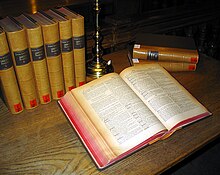| This page in a nutshell: Wikipedia's Verifiability policy requires inline citations for any material challenged, or likely to be challenged, and for all quotations, anywhere in article space. |

Telling people where the information and facts that are put into articles comes from is an important part of Wikipedia. You should add a citation for the sources of information. To make a citation, or cite a fact means to quote by example, to give authority, and to provide proof.[1] This helps to make sure the facts are right and can be verified (checked to make sure that the information comes from somewhere and so is true) by the readers.
If someone sees that there is information in an article that does not have a source, then the information may be removed.
The sources used should be trustworthy and from a reliable source. The information should be distributed by a special group that is well-known for checking their own facts as well, making sure the information is correct or true.
On the article page, you should list in numerical order where the facts come from in a section called "References".
If you use citations inside the article paragraphs (this is preferred), then you need to set up the article references section with
== References ==
{{reflist}}
Inline source citations use tags in the form of <ref> reference information here </ref> . Inline citations are often placed at the end of a sentence or paragraph immediately following the sentence punctuation mark. When using inline source citations with tags, the sources listed in the References section will be automatically numbered.